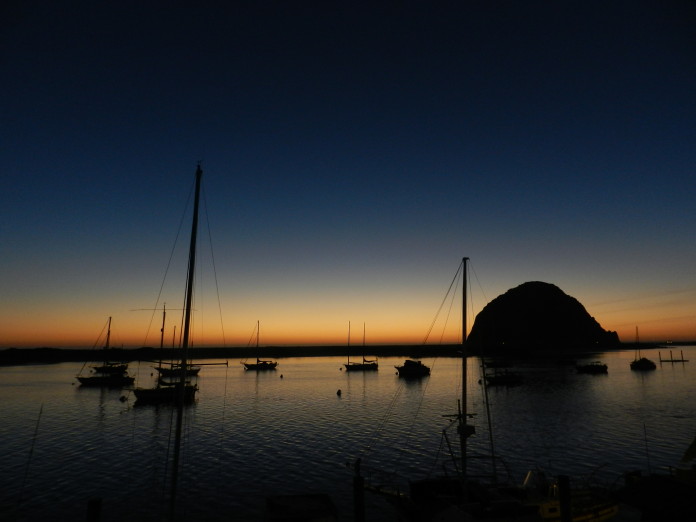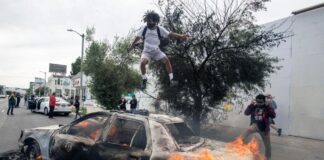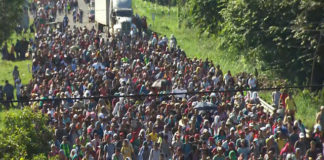
A native bears witness to the end of the Golden State
By Mark Cromer
[This essay was first published in 2010 by Noozhawk in Santa Barbara.]
“This is a story about love and death in the golden land, and begins with the country.” — Joan Didion, from Some Dreamers of the Golden Dream
California, the adage once held, is a place where seemingly everyone comes from somewhere else.
The Pacific borderland of America’s epic push westward that was transformed from a dusty western outpost where speculators risked all to pull gold from the ground into a mythical Mecca where those desperate dreamers that Didion so famously detailed came seeking the quintessential good life.
And the word was that California was indeed a place where the good life was as ripe, sweet and accessible as the low-hanging fruit in the ubiquitous orchards that sprang from its fertile earth.
The cynics would come to deride the state as little more than a vast tidal pool brimming with eccentrics, outlaws, riff-raff and professional loafers posing as gurus with ‘The Answer,’ but those who lived here knew the pleasant truth: while perhaps not a divine Holy Land; California was a beautiful, promising place to live.
In the summer of 1985 that promise was as indisputably real to me as the waves that I watched roll in off Ventura, where my friends and I had rallied our VW minibus to catch the Grateful Dead as the quintessential California band enjoyed its second act in American rock n’ roll. Jerry and Bob grooved out Sugar Magnolia as thousands of us young Californians danced on the beach and in the fairgrounds like young Romans gleeful of our inheritance. Our tribal fires burned bright at night as braless hippie girls served electric strawberries and free love seemed somehow not only hip again, but wonderfully true. Valid. Just weeks earlier I had got to hang out with California’s counterculture ombudsman, Timothy Leary, and his intrinsic Zen had partially rubbed off on me and my friends, so we said ‘yes’ a lot and considered it a personal revolutionary act.
Looking back now, a Doors song we sang that summer was a portent of things to come:
“Morning found us
calmly unaware
noon burned gold into our hair
at night we swam the laughing sea
when summer’s gone
where will we be?”
A second-generation Southern California native, I was born in 1965, when the real world manifestations of the California Dream were arguably at their zenith. Governor Edmund G. ‘Pat’ Brown was overseeing a massive investment into the state’s infrastructure, seeking to ensure a quality of life for most Californians as comfortable as the state’s legendary warm weather.
In 1965, there were just over 18 million people living in California, a sustainable population that could accommodate reasonable growth while continuing to expand opportunity and comfort for its citizens. It was a time when the state’s great coastal cities, Los Angeles and San Francisco, were giving birth to the fabled youth culture that would be instrumental in shaping the world’s perception of America, and of California as an oasis where one could “take it easy.”
Indeed, the hippie aesthetic that emerged full bloom in California during the 1960s was imbued with a variety of traditional agrarian qualities that were melded with the more progressive sensibilities that were reshaping the cities. It was a time when coastline communities from Laguna to Big Sur were still real bohemian enclaves of artists and writers mingling with academics and old money; distinct places separated by undeveloped coast that were connected by the veins of open asphalt.
In the vernacular of the era, California was peaking.
Even in Sacramento, the prospect of some endless summer seemed to waft in the legislative air. Development and the notion of “progress” were a means to a desirable end; not-yet having mutated into runaway growth with no end in sight.
“My son asked me what I hoped to accomplish as governor,” Brown remarked. “I told him: essentially to make life more comfortable for people, as far as government can. I think that embraces everything from developing the water resources vital to California’s growth, to getting a man to work and back fifteen minutes earlier if it can be done through a state highway program.”
Those were the days.
By 1975, the nation’s hangover from the Vietnam War and the battle for civil rights settled into the malaise of the Ford and Carter era. While California’s luster still glimmered like so many Chinese lanterns on a summer’s night, the scent of decay was slowly rising about the sweetness of the night-blooming jasmine that hung in the air. Across the dusty stretch of Southern California, open space and architecture rich with history still allowed cities and towns a sense of distinct identity, a place and time where the phrase “city limits” implied an undeveloped landscape beyond.
In the Pomona Valley, reminders of the region’s citrus growing past could still be easily glimpsed, with old orange groves dotted with smudge pots on virtually every other block. To the west lay the rolling hillsides of Walnut and Diamond Bar, and to the south the great dairies and farms of Chino, Ontario, Norco and Corona with thousands of heads of cattle. Lush vineyards and eucalyptus groves broke up the scattered homes in Upland, Alta Loma and Cucamonga along the foothills that ran into the eastern reaches of the Pomona Valley at the base of the Cajon Pass. The belching smoke stacks of Kaiser Steel in Fontana served as a reminder of the industrial might of the blue-collar, skilled labor jobs that anchored the region’s post-war prosperity, along with military-industrial complex giants like General Dynamics, Lockheed Martin, Xerox and PerkinElmer.
While it was growing a little rougher around the edges, the inherent balance of the community was still evident throughout everyday life.
Those days are long, long gone—much like the open fields that once defined them.
The industrial giants that had anchored either end of the Pomona Valley closed down years ago, taking tens of thousands of skilled labor jobs and wages with them, an economic bleed-out that sapped the region, leaving it staggering like an anemic man promised a transfusion even as Washington winked and read the Last Rites.
Following the Reagan boom years and the bust of George H. W. Bush’s administration, the population of the valley, like much of the rest of Southern California, began to grow dramatically, with new tracts of homes and multi-family apartments being erected in the old groves and fields. Even as the region was shedding large numbers of jobs, it was conversely adding large numbers of people. And for the first time in memory, by the mid-1990s, increasingly large numbers of those people coming to the valley were Spanish-speaking immigrants, most of them from Mexico and many of them in the country illegally.
In Pomona proper, the impact could be seen clearly, from the increasingly crowded emergency rooms to the portable classrooms that began to fill the blacktops of playgrounds and the grassy fields where students once played sports or enjoyed leisure time with their families.
Apartment complexes first, and then single family homes, began to overfill with two, three and four families at a time living in space designed for one. Garages across the city began to double as additional homes for even more immigrant families. As traditional mom and pop American businesses closed their doors, victims of an eroding middle-class base, small shops catering specifically to Mexican immigrants began to spring up along the old commercial loops of Holt Avenue and Mission Boulevard.
Like a domino effect, as Pomona’s immigrant population surged, more school space was needed than could be built, so the school district began taking over failed retail and commercial space and converted them into classrooms.
By the dawn of the millennium, Pomona’s transformation was complete. In less than two decades, an immigrant tsunami swept through the city and irrevocably reshaped its demographics. By 2004, the city’s officially projected population of just under 150,000 people was nearly 65-percent Latino; but that figure is almost certainly an undercount considering the thousands—possibly tens of thousands—of illegal immigrants living in converted garages, transient motel rooms and apartments that are unlikely to participate in a government census canvass.
The ethnic shift in the city’s public schools has been even more staggering and the true diversity that once was a hallmark of the Pomona Unified School District has been virtually eliminated altogether. With mostly immigrant Latinos now cresting to nearly 90-percent majorities on many of the campuses, Pomona today is nowhere near as diverse a city as it was when I was growing up on its streets 30 years ago, an era when Anglos, blacks and Chicanos mingled together in relative balance, all connected by economic and common cultural threads. Today, the elementary school I first enrolled in 1970 is now 90-percent Latino, with nearly that same amount on the subsidized lunch and breakfast programs. My old junior high is now 89-percent Latino, with 92-percent getting a “free” breakfast and lunch. The high school I attended, like my parents before me in the 1950s, is now 82-percent Latino, with an equal amount of its nearly 1,600 students on tax-supported meals.
But the ethnic cleansing is only half of it.
All three of my old schools today test dismally amid an already horrifically performing state system, despite hundreds of millions of dollars that Pomona Unified has thrown over the years into its blast furnace of curriculum and programs designed to teach the value of education to an immigrant population that comes from countries where education ranks somewhere between selling Chiclets on the street and bussing tables.
It was not always this way.
When I was a kid in Pomona, our fathers worked in the same plants together, our mothers shopped in the same stores and our families grew to know each other. And we all spoke the same language in front of each other as well as mostly at home. Today, Pomona stands as a tribute to the remaking of Southern California as a region that is rapidly becoming ethnically homogenous, in reality a far northern state of Mexico, if remaining American in name only. Los Angeles County Supervisor Mike Antonovich told me in early 2008 that as many as 2 million illegal immigrants called the county home; an explosive figure that has almost certainly remained static even in the dismal economic climate and possibly even grown larger.
My old friend and colleague Charles Rappleye, a respected author and journalist, sees this epic demographic and cultural shift as nothing less than a positive development. Rappleye is a New England Yankee who first moved to Santa Barbara in the 1970s before finding his way down the coast to Los Angeles, where he still lives today in fashionably bohemian Echo Park. In an essay published in the esteemed Virginia Quarterly Review in the spring of 2007, Rappleye made his case that the tidal wave of refugees fleeing the failed state of Mexico is little more than the natural flow of indigenous peoples along their historic migratory routes.
It can’t be stopped, he asserts. Nor should it be.
Rappleye cites my own history as a native Californian and my deep connection with the town of my birth throughout the essay, employing my perspective as ballast to give his argument some multi-dimensional nuance. He acknowledges the sense of loss that fellow baby-boomer Anglos like me are experiencing as we watch the literal remaking—Rappleye might describe it as a ‘re-imagining’—of the state we once knew into something we no longer even recognize.
“What of America?” Rappleye writes. “The future of course is impossible to predict. Our country is changing, that much is certain, and I think that is what spurs people like Pat Buchanan and my friend Mark alike. They want to alert the citizenry before it is too late, but they are trying to turn back the clock. What they see as realism, I see as nostalgia. The day of Mark’s father, of the unskilled worker taking home a middle class paycheck, is gone, and no amount of recrimination will change that.”
A compelling writer with a penchant for flair, Rappleye views my distress over what I have witnessed, the end of California’s golden era and its descent into an overcrowded and financially failed state that struggles to provide even adequate basic services for its citizens, as needlessly alarmist.
Perhaps, as my old friend suggests in his essay, I am nostalgic. But if so, then I am nostalgic much like the passengers of the Titanic must have been as they boarded those too few life boats, stunned that such a glittering ship which seemed a mighty testament to a grand design was torn open, flooded and sent to the bottom in short order.
As Rappleye sees in me a powerful yearning for a bygone era that will never return, I see in him the pie-eyed prayer for a utopian age that will never arrive.
His take on the largest sustained human migration that any nation in the history of nations has been forced to accommodate in such a short period of time is liberally embellished with politically correct cherries like ‘social justice’ that ostensibly sweetens the dish for the American taste for benevolence. Yet in the cold air of reality that hangs outside philosophical dinner parties, such slogans have little real meaning.
To the African-American citizens in south Los Angeles, who have watched as their neighborhoods and communities have been literally overrun with illegal immigrants (some high schools built to accommodate 1,000 students have grown to now house—yes, literally house, not educate—as many as 4,000 kids), there is a bitter irony in lofty progressive cant about justice for illegal immigrants even as blacks find themselves again being pushed to the back of the economic bus.
Rappleye and his fellow travelers see no crisis in the staggering waves of illegal immigration, or the unsustainable population densities that it builds, because quite frankly they don’t suffer from its impact in the same immediate sense or on the same scale. Sure, they often face the crowded freeways and long lines that everyone else does in Los Angeles County, but they aren’t fighting to maintain a precarious toe-hold above an existence of functional poverty. The stakes are not an existential threat to them. They do not compete with illegal immigrants for jobs, they do not send their children to schools that are jammed beyond capacity, they do not rely on a frayed safety net of social services that are perilously close to falling away completely in Southern California.
On a day-to-day basis, they simply live in a different, parallel universe.
Yes, I am saddened at the loss of the geographic and cultural aesthetic that once defined my own hometown and much of Southern California, but my fear of what I am witnessing and my sense of outrage at those who are letting it happen—indeed abetting it—has a wellspring far deeper than merely the loss of something I was fortunate enough to have experienced. It is steeped in a sense of obligation to my fellow Americans, especially those who are struggling for a chance to attain the quality of life that many others of us enjoyed as a result of our parents devotion to the American ideal.
Yet in Rappleye’s world, that brand of American nationalism must seem as passé as flying the flag on the Fourth of July, a benign if rather quaint tradition—or “nostalgic” as he might say.
But my friend Charlie is at least candidly honest about his perspective of California and America’s future, a refreshing if rare quality among many of those who share his views.
“Rather than fortify the border, another exercise in the failed, punitive mode, why not open it, granting open-ended visas to all Mexicans who apply,” he offers in the Virginia Quarterly Review. “And, later, citizenship to any?”
Rappleye’s suggestion may be effectively moot in a matter of another couple of generations if the present pace of mass immigration into the United States continues unabated, with the nation projected to reach a population of 500 million people by 2050 and perhaps a billion people at the dawn of the 22nd century.
Citizenship then may be as easily accessible as a counterfeit driver’s license is now in the bustling bazaars of Los Angeles, Chicago, Las Vegas and Phoenix that churn out the fraudulent documents that migrants now use to navigate the country they broke into. But by then, two or three generations deeper into this crisis, the real question will be what that citizenship will be worth? What cherished hallmarks will the designation “American” then hold?
Like the microcosm of Southern California, it will be a nation that is brimming with people struggling to survive and yet with even less of a cohesive sense of a national identity—of just what an American is—than at any other time in the country’s history. Perhaps, as Rappleye suggests, the threshold for citizenship should be anyone who simply declares it, and thus the meaning of American will simply be whatever one wishes it to be. Instead of a bedrock sense of ideals and values; it will be malleable, transitory, written in chalk.
Ironically, far from bringing more people closer to the “American Dream,” that once-perennial hope which defined a country and provided more opportunity for its citizens than any other nation on earth, will now be further away than ever before for most of its people. So yes, I raise a nostalgic lament for a time that once was in California. Because it was a real time and place—there was a fundamental truth underpinning the California myth— before it slipped away into a smoldering memory. As with a fallen friend, I remember the good times and I honor them. It is important.
And California’s grim fate should serve as a warning for the rest of the nation.
There are towns, counties and states that are experiencing, like California in the late 1980s and early 1990s, exploding populations of illegal immigrants that are reshaping their communities, their culture and their quality of life at a pace and on a scale that would have been unimaginable a generation ago. Fifteen years ago, it would have been hard to imagine that what was happening to California would in fact continue and grow worse. Californians thought that a compelling electoral consensus like Proposition 187, which passed with an overwhelming 60-percent of the vote in 1994, would stem the tide. Far from it, the cycle of mass Mexican immigration into the United States has continued apace, an exodus on a near Biblical-scale that has emptied entire regions of the narco-confederation to the south.
In places like Pennsylvania, Arkansas and Georgia, the future is being decided today.
If American citizens cannot muster the political will to act decisively to preserve their overarching culture and the quality of life that was passed along to them after so much sacrifice across the 20th Century, then they will find themselves in the same terminal condition that California is in today.
An inglorious ending for a nation whose lamps once burned so bright with promise.










